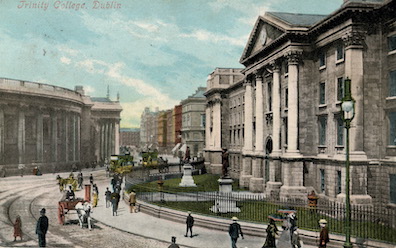§ As
Bloom walks south from Westmoreland Street toward Grafton
Street in Lestrygonians, he passes between the busy
traffic on College Green and the iron
railings of Trinity College, Dublin: "His smile faded as he
walked, a heavy cloud hiding the sun slowly, shadowing
Trinity's surly front. Trams passed one another, ingoing,
outgoing, clanging." The large door of Trinity's main entrance
stands in an imposing four-story Palladian wall adorned with
Corinthian columns. § The
word that the narrative applies to this grand facade once
referred to the manner of an aristocrat ("sir," hence the
original spelling "sirly"). The OED lists a rare
obsolete meaning of "Lordly, majestic" and the more common old
meaning "Masterful, imperious; haughty, arrogrant,
supercilious." In modern democratic times the quality of
supercilious haughtiness associated with feudal lords has
given the word purely negative connotations. Joyce no doubt
intends these more familiar meanings too, since he associates
Trinity with the reactionary politics and social snobbery of
the ruling class.
Trinity College was
founded under letters patent from Queen Elizabeth in 1592 as the
first college of a University of Dublin intended to resemble
Oxford and Cambridge. Although it has remained the university's
sole college, Trinity has a long and distinguished history of
teaching and research, and many of Ireland's greatest writers
and thinkers have earned degrees there. Historically a bastion
of Anglo-Irish Protestants, it functioned throughout the 18th
century as the preserve of the newly empowered Ascendancy class.
In the last few decades of that century the college admitted
Catholics, but until 1793 they could not graduate without
swearing unconscionable oaths of allegiance to the
Anglican
establishment.
During the 19th century Trinity abolished all doctrinal tests,
but strong resentments persisted on both sides of the sectarian
divide. In 1871, responding to the successful 1854 establishment
of a Catholic university (Joyce's alma mater), Catholic bishops
banned their parishioners from attending Trinity (a ban which
some Catholics, like
Oliver St. John Gogarty,
ignored). In the final decades of the century, when Irish
politics were defined by the contest between defenders of Union
and proponents of Home Rule, Trinity faculty and students firmly
espoused the Unionist cause.
In
Lestrygonians Joyce alludes to many key aspects of
this bitter divide, starting with the 1800
Act of Union.
Sixteen paragraphs before he sees the college's "surly front,"
Bloom's path of travel takes him past the Bank of Ireland
building, but the narrative does not refer to it in that way: "
Before
the huge high door of the Irish house of parliament a flock of
pigeons flew." When the Irish Parliament was abolished,
the building that had housed it was sold, with the condition
that it could never again be restored to its original use.
More political resonances follow. As Bloom walks past the bank
he sees uniformed police officers exiting from a station on "
College
street," on the north side of the campus. They make him
think of the massive protests that filled Dublin's streets in
December 1899, on "
the day Joe Chamberlain was given his
degree in Trinity." Awarding an honorary degree to
the
chief government architect of British imperial warmongering in
South Africa was a polemical choice designed to
demonstrate Ireland's acquiescence in the scheme. It backfired,
causing Catholics to take to the streets to show that the
university's political views were not those of all Irish men and
women. Bloom remembers the violent crackdown by policemen and
soldiers, as well as the counter-demonstrators who spilled out
of the campus to confront the protesters: "
And the Trinity
jibs in their mortarboards. Looking for trouble." Then he
thinks more broadly of republican insurrectionists, anticolonial
political movements, plainclothes spies, and police informants.
After these sixteen paragraphs evoking more than a century of
struggle between Anglo-Irish Protestant rulers and Catholics
seeking a voice in the government of their country, Joyce's "
surly
front" resounds with implied meanings. The Trinity facade
is majestic, masterful, lordly, as befits the ruling class that
the college serves. But to middle-class Catholics excluded from
its classrooms and opposed to its Unionist politics it appears
haughty and arrogant, and probably also surly in the modern
sense: churlish, sullen, ill-humored, uncivil. Joyce points up
these implications by having "
a heavy cloud" occlude the
sun as Bloom approaches the college, casting its stonework into
shadow. The narrative notes that "
His smile faded," and
in the four paragraphs that follow this meteorological event his
thoughts become very dark, just as they did when
a cloud
blotted out the sun in
Calypso. The effect of this
entire section of
Lestrygonians is to make Trinity a
darkly forbidding place associated with political repression and
social exclusion.
One of the most eminent Trinity dons of Joyce's era, John
Pentland Mahaffy, the distinguished classicist, brilliant
conversationalist, and devout royalist who mentored both Oscar
Wilde and Gogarty, represented a level of educational
excellence to which poor Catholics could not hope to gain
access. In his biography of Joyce, Richard Ellmann observes
that at this time Trinity "had a more distinguished faculty"
than did University College, and he records Mahaffy's remark
that "James Joyce is a living argument in favor of my
contention that it was a mistake to establish a separate
university for the aborigines of this island––for the
corner-boys who spit into the Liffey" (58). Ellmann does not
provide a date for this remark or speculate about whether
Joyce knew of it, but it is certainly surly, in all senses of
that word.



